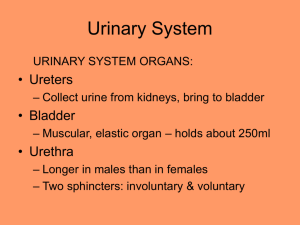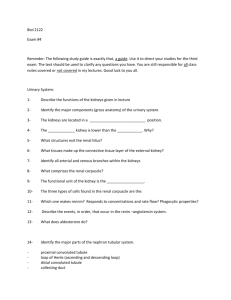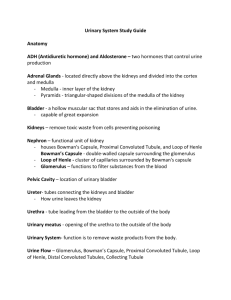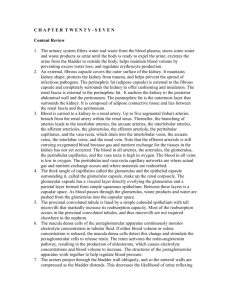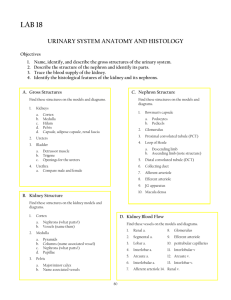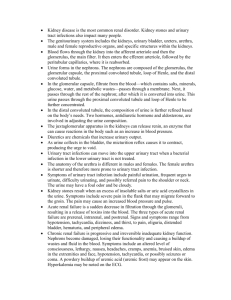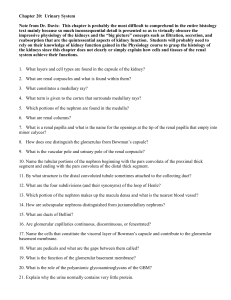A-SG15. Study guide for chapter 15.
advertisement
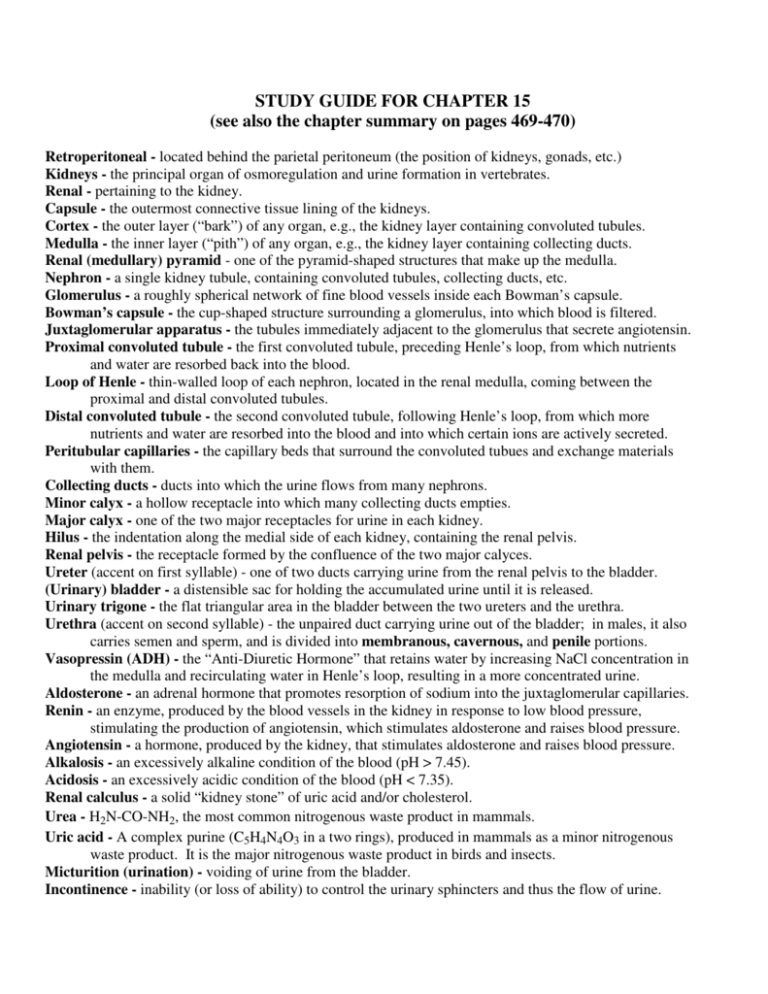
STUDY GUIDE FOR CHAPTER 15 (see also the chapter summary on pages 469-470) Retroperitoneal - located behind the parietal peritoneum (the position of kidneys, gonads, etc.) Kidneys - the principal organ of osmoregulation and urine formation in vertebrates. Renal - pertaining to the kidney. Capsule - the outermost connective tissue lining of the kidneys. Cortex - the outer layer (“bark”) of any organ, e.g., the kidney layer containing convoluted tubules. Medulla - the inner layer (“pith”) of any organ, e.g., the kidney layer containing collecting ducts. Renal (medullary) pyramid - one of the pyramid-shaped structures that make up the medulla. Nephron - a single kidney tubule, containing convoluted tubules, collecting ducts, etc. Glomerulus - a roughly spherical network of fine blood vessels inside each Bowman’s capsule. Bowman’s capsule - the cup-shaped structure surrounding a glomerulus, into which blood is filtered. Juxtaglomerular apparatus - the tubules immediately adjacent to the glomerulus that secrete angiotensin. Proximal convoluted tubule - the first convoluted tubule, preceding Henle’s loop, from which nutrients and water are resorbed back into the blood. Loop of Henle - thin-walled loop of each nephron, located in the renal medulla, coming between the proximal and distal convoluted tubules. Distal convoluted tubule - the second convoluted tubule, following Henle’s loop, from which more nutrients and water are resorbed into the blood and into which certain ions are actively secreted. Peritubular capillaries - the capillary beds that surround the convoluted tubues and exchange materials with them. Collecting ducts - ducts into which the urine flows from many nephrons. Minor calyx - a hollow receptacle into which many collecting ducts empties. Major calyx - one of the two major receptacles for urine in each kidney. Hilus - the indentation along the medial side of each kidney, containing the renal pelvis. Renal pelvis - the receptacle formed by the confluence of the two major calyces. Ureter (accent on first syllable) - one of two ducts carrying urine from the renal pelvis to the bladder. (Urinary) bladder - a distensible sac for holding the accumulated urine until it is released. Urinary trigone - the flat triangular area in the bladder between the two ureters and the urethra. Urethra (accent on second syllable) - the unpaired duct carrying urine out of the bladder; in males, it also carries semen and sperm, and is divided into membranous, cavernous, and penile portions. Vasopressin (ADH) - the “Anti-Diuretic Hormone” that retains water by increasing NaCl concentration in the medulla and recirculating water in Henle’s loop, resulting in a more concentrated urine. Aldosterone - an adrenal hormone that promotes resorption of sodium into the juxtaglomerular capillaries. Renin - an enzyme, produced by the blood vessels in the kidney in response to low blood pressure, stimulating the production of angiotensin, which stimulates aldosterone and raises blood pressure. Angiotensin - a hormone, produced by the kidney, that stimulates aldosterone and raises blood pressure. Alkalosis - an excessively alkaline condition of the blood (pH > 7.45). Acidosis - an excessively acidic condition of the blood (pH < 7.35). Renal calculus - a solid “kidney stone” of uric acid and/or cholesterol. Urea - H2N-CO-NH2, the most common nitrogenous waste product in mammals. Uric acid - A complex purine (C5H4N4O3 in a two rings), produced in mammals as a minor nitrogenous waste product. It is the major nitrogenous waste product in birds and insects. Micturition (urination) - voiding of urine from the bladder. Incontinence - inability (or loss of ability) to control the urinary sphincters and thus the flow of urine.


